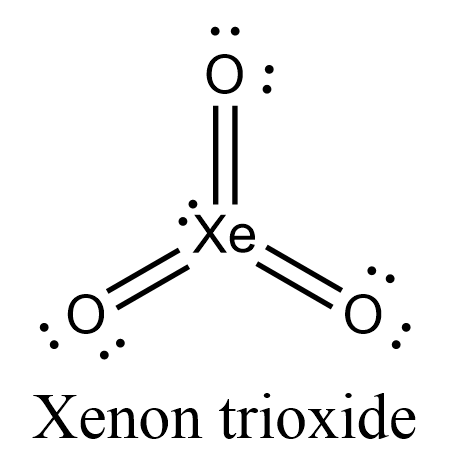
The geometry of
(A) linear
(B) planar
(C) pyramidal
(D) T-shaped
Answer
498.9k+ views
1 likes
Hint: Start by writing electronic configuration in Xenon oxide. Calculate the number of electron pairs in the given molecule,
Complete step by step answer:
- Xenon belongs to the group of inert gases and it has the atomic number 54.
- Its electronic configuration is,
- Oxygen has the atomic number 8. Its electronic configuration is,
- For Xenon trioxide,
- Xenon has 8 valence electrons and oxygen has 6 valence electrons.
- Therefore,
- Let’s draw the Lewis structure for

- In this structure, we can see that all 13 electron pairs are present either as bond-pairs or as lone-pairs.
- Let’s take a look at its hybridization now. Xenon has vacant 5d orbitals so, when xenon gets excited its fifth orbital configuration will become
- Therefore, Xenon in xenon trioxide will have three
- Oxygen will undergo
- The three
- Now, each oxygen atom has two lone pairs of electrons and a xenon atom has one lone pair of electrons. Xenon and oxygen are doubly bonded to each other.
- Due to the presence of lone pair on central atom Xenon, there will be lone pair-bond pair repulsion in the molecule. So, the trigonal planar geometry will be distorted to form pyramidal geometry.

- Therefore, the geometry of
So, the correct answer is “Option C”.
Note: Remember when there is a lone pair present on the central atom, there will be lone pair- bond pair repulsion between the central atom and the other atoms linked to it. This will lead to distortion of geometry. Xenon trioxide is an unstable compound and it is a very powerful oxidizing agent.
Complete step by step answer:
- Xenon belongs to the group of inert gases and it has the atomic number 54.
- Its electronic configuration is,
- Oxygen has the atomic number 8. Its electronic configuration is,
- For Xenon trioxide,
- Xenon has 8 valence electrons and oxygen has 6 valence electrons.
- Therefore,
- Let’s draw the Lewis structure for

- In this structure, we can see that all 13 electron pairs are present either as bond-pairs or as lone-pairs.
- Let’s take a look at its hybridization now. Xenon has vacant 5d orbitals so, when xenon gets excited its fifth orbital configuration will become
- Therefore, Xenon in xenon trioxide will have three
- Oxygen will undergo
- The three
- Now, each oxygen atom has two lone pairs of electrons and a xenon atom has one lone pair of electrons. Xenon and oxygen are doubly bonded to each other.
- Due to the presence of lone pair on central atom Xenon, there will be lone pair-bond pair repulsion in the molecule. So, the trigonal planar geometry will be distorted to form pyramidal geometry.

- Therefore, the geometry of
So, the correct answer is “Option C”.
Note: Remember when there is a lone pair present on the central atom, there will be lone pair- bond pair repulsion between the central atom and the other atoms linked to it. This will lead to distortion of geometry. Xenon trioxide is an unstable compound and it is a very powerful oxidizing agent.
Latest Vedantu courses for you
Grade 7 | CBSE | SCHOOL | English
Vedantu 7 CBSE Pro Course - (2025-26)
School Full course for CBSE students
₹45,300 per year
Recently Updated Pages
Master Class 11 Economics: Engaging Questions & Answers for Success

Master Class 11 Business Studies: Engaging Questions & Answers for Success

Master Class 11 Accountancy: Engaging Questions & Answers for Success

Master Class 11 English: Engaging Questions & Answers for Success

Master Class 11 Computer Science: Engaging Questions & Answers for Success

Master Class 11 Maths: Engaging Questions & Answers for Success

Trending doubts
State and prove Bernoullis theorem class 11 physics CBSE

1 ton equals to A 100 kg B 1000 kg C 10 kg D 10000 class 11 physics CBSE

State the laws of reflection of light

One Metric ton is equal to kg A 10000 B 1000 C 100 class 11 physics CBSE

1 Quintal is equal to a 110 kg b 10 kg c 100kg d 1000 class 11 physics CBSE

Difference Between Prokaryotic Cells and Eukaryotic Cells




